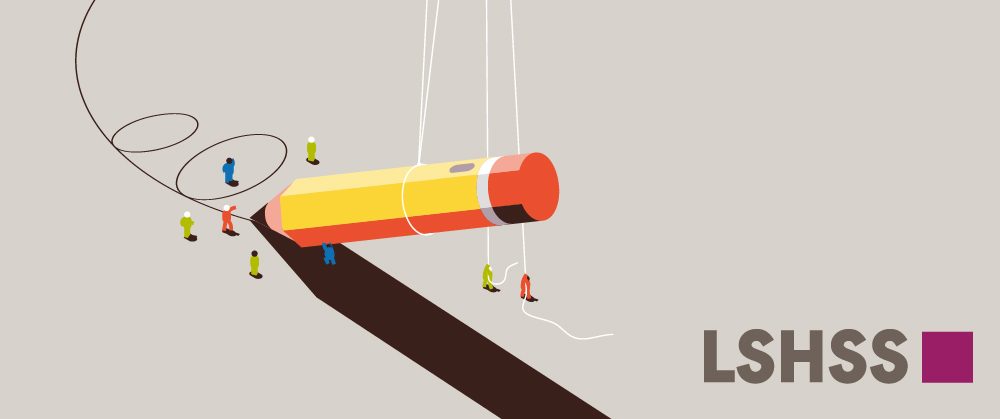Grammatical difficulties can be associated with developmental language disorder (DLD), autism, hearing impairment, intellectual disability, and complex communication needs—diagnoses that nearly every speech-language pathologist (SLP) will work with at some point. Amanda Owen Van Horne has curated 10 articles for the latest Language, Speech, and Hearing Services in Schools (LSHSS) forum,titled “Morphosyntax Assessment and Intervention for Children.” These articles can help SLPs develop and adopt treatment approaches for children—regardless of their diagnoses and across a number of languages.
In her introduction, Owen Van Horne summarizes the articles and current innovations in vocabulary instruction. She emphasizes the need for not only grammar education but also assessment. Two articles focus specifically on assessing grammar. A tutorial by Finestack and colleagues (2020) focuses on using freely available computer language analysis to code for language and parts of speech. In her introduction, Owen Van Horne writes that although this software can seem daunting, “this tutorial provides precise codes and clear guidelines for use” (Owen Van Horne, 2020, p. 181). Although children with DLD who speak English tend to make errors primarily in the verbal domain, less is known about DLD markers for monolingual speakers of other languages. In their article, Castilla-Earls and colleagues (2020) focus on monolingual Spanish-speaking children with DLD, looking to pin down the morphological markers with the best diagnostic accuracy for monolingual Spanish-speaking children.
Two articles explain the need to target grammatical skills. Binger et al. (2020) argue that instructors should focus on all areas of language, including grammar—even for young children, children with limited intelligibility, or children with limited vocabularies. In another article, Curran (2020) points out that because children in elementary school are expected to read and listen to complex sentences as early as third grade, SLPs should target these types of sentences during treatment in order to help the child succeed in the classroom.
Other authors in this forum explore the challenges inherent in using (a) traditional approaches to teach grammar, (b) manualized instruction, (c) explicit instruction, and (d) clinician-directed approaches. Two authors focused on manualized approaches, where children aren’t provided specific guidance. Bruinsma et al. (2020) investigated the effectiveness of Language in Interaction Therapy (LIT), a program designed for Dutch SLPs to use with their students in order to elicit, and train students about, proper grammar. Meanwhile, Bedore et al. (2020) studied another type of curriculum—Early Interventions in Reading— for children who speak Spanish and English, incorporating goals beyond grammar.
Three articles examined explicit approaches to grammar instruction that communicate a target and rules directly. Balthazar and colleagues (2020) contrasted three such approaches, focusing on complex syntax, summarizing the evidence for each approach, and including samples of each in practice. Calder et al. (2020) presented a single-case study focused on metalinguistic approaches for 5- and 6-year old children; this is especially apt because of the common misconception that metalinguistic approaches are appropriate only for older children. Despite the fact that imitation is an understudied treatment approach, Eisenberg et al. (2020) determined in their detailed tutorial that it is indeed evidence based, although the nuances of the approach remain unstudied.
We’d like to thank Dr. Owen Van Horne for her work as guest editor of this important forum. In her introduction, Owen Van Horne writes that “grammar is important for basic communication . . . and academic success . . . yet can also be challenging to implement given systematic constraints” (p. 181). We hope that you find the latest forum from LSHSS both inspiring and enlightening! Explore the entire forum here, or check out the individual articles below.
Explore the Forum
Balthazar, C. H., Ebbels, S., & Zwitserlood, R. (2020). Explicit grammatical intervention for developmental language disorder: Three approaches. Language, Speech, and Hearing Services in Schools, 51(2), 226–246. https://doi.org/10.1044/2019_LSHSS-19-00046
Bedore, L. M., Peña, E. D., Fiestas, C., & Lugo-Neris, M. J. (2020). Language and literacy together: Supporting grammatical development in dual language learners with risk for language and learning difficulties. Language, Speech, and Hearing Services in Schools, 51(2), 282–297. https://doi.org/10.1044/2020_LSHSS-19-00055
Binger, C., Kent-Walsh, J., Harrington, N., & Hollerbach, Q. C. (2020 Tracking early sentence-building progress in graphic symbol communication. Language, Speech, and Hearing Services in Schools, 51(2), 317–328. https://doi.org/10.1044/2019_LSHSS-19-00065
Bruinsma, G., Wijnen, F., & Gerrits, E. (2020). Focused stimulation intervention in 4- and 5-year-old children with developmental language disorder: Exploring implementation in clinical practice. Language, Speech, and Hearing Services in Schools, 51(2), 247–269. https://doi.org/10.1044/2020_LSHSS-19-00069
Calder, S. D., Claessen, M., Ebbels, S., & Leitão, S. (2020). Explicit grammar intervention in young school-aged children with developmental language disorder: An efficacy study using single-case experimental design. Language, Speech, and Hearing Services in Schools, 51(2), 298–316. https://doi.org/10.1044/2019_LSHSS-19-00060
Castilla-Earls, A., Auza, A., Pérez-Leroux, A. T., Fulcher-Rood, K., & Barr, C. (2020). Morphological errors in monolingual Spanish-speaking children with and without developmental language disorders. Language, Speech, and Hearing Services in Schools, 51(2), 270–281. https://doi.org/10.1044/2019_LSHSS-19-00022
Curran, M. (2020). Complex sentences in an elementary science curriculum: A research note. Language, Speech, and Hearing Services in Schools, 51(2), 329–335. https://doi.org/10.1044/2019_LSHSS-19-00064
Eisenberg, S. L., Bredin-Oja, S. L., & Crumrine, K. (2020). . Use of imitation training for targeting grammar: A narrative review. Language, Speech, and Hearing Services in Schools, 51(2), 205–225. https://doi.org/10.1044/2019_LSHSS-19-00024
Finestack, L. H., Rohwer, B., Hilliard, L., & Abbeduto, L. (2020). Using computerized language analysis to evaluate grammatical skills. Language, Speech, and Hearing Services in Schools, 51(2), 184–204. https://doi.org/10.1044/2019_LSHSS-19-00032
Owen Van Horne, A. J. (2020). Forum on morphosyntax assessment and intervention for children. Language, Speech, and Hearing Services in Schools, 51(2), 179–183. https://doi.org/10.1044/2020_LSHSS-20-00018







